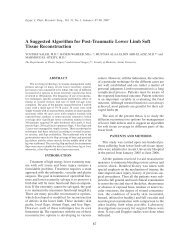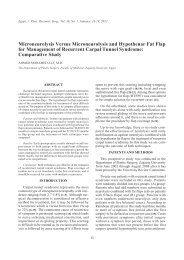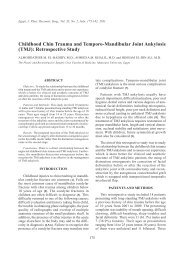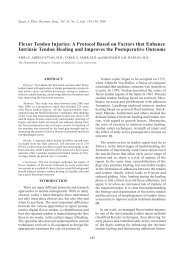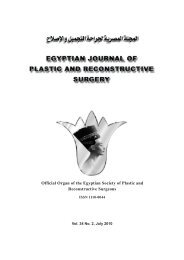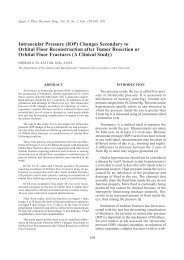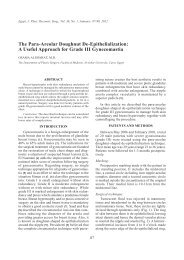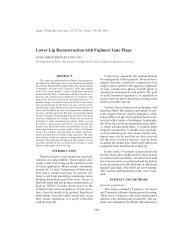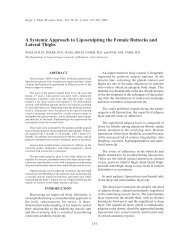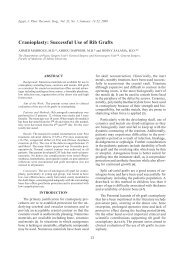Vermillion Notch After Millard Repair of Unilateral Cleft Lip - ESPRS
Vermillion Notch After Millard Repair of Unilateral Cleft Lip - ESPRS
Vermillion Notch After Millard Repair of Unilateral Cleft Lip - ESPRS
You also want an ePaper? Increase the reach of your titles
YUMPU automatically turns print PDFs into web optimized ePapers that Google loves.
280 Vol. 33, No. 2 / <strong>Vermillion</strong> <strong>Notch</strong> <strong>After</strong> <strong>Millard</strong> <strong>Repair</strong> <strong>of</strong> <strong>Unilateral</strong> <strong>Cleft</strong> <strong>Lip</strong><br />
The objective <strong>of</strong> this article is to analyze different<br />
factors responsible for vermillion notching<br />
and assess the results <strong>of</strong> labial revisions addressing<br />
these factors.<br />
MATERIAL AND METHODS<br />
Twenty children with vermillion notching after<br />
<strong>Millard</strong> repair <strong>of</strong> unilateral cleft lip were included<br />
in this study. Age <strong>of</strong> the patients ranged from 2-<br />
12 years with a mean <strong>of</strong> 4.3 years. Six patients<br />
were males while 14 were females. They were<br />
operated upon for their secondary lip deformity<br />
by the authors at the Children’s Hospital, Cairo<br />
University (Aboul Reesh), during the period from<br />
January 2006 till December 2008.<br />
All patients had had their previous lip repair<br />
performed using the classic <strong>Millard</strong> rotationadvancement<br />
flap technique. Preoperative assessment<br />
was performed clinically together with preoperative<br />
standard photography. Assessment included<br />
lip length as compared to the non-cleft side<br />
(short/equal), integrity <strong>of</strong> Cupid’s bow (smooth/<br />
tented), vermillion fullness on either side <strong>of</strong> the<br />
notch (near normal fullness/deficient), the severity<br />
<strong>of</strong> the notch (mild/severe) and the quality <strong>of</strong> the<br />
scar (masked/obvious) (Table 1).<br />
Table (1): Results <strong>of</strong> preoperative assessment.<br />
Item<br />
Short <strong>Lip</strong><br />
Tented Cupid’s Bow<br />
Deficient <strong>Vermillion</strong><br />
Severe <strong>Notch</strong>ing<br />
Obvious Scar<br />
Number<br />
Percentage<br />
All corrective procedures were performed under<br />
general anesthesia. The technique was tailored<br />
according to pre and intra-operative findings. Intraoperative<br />
assessment included the bulk <strong>of</strong> muscle<br />
fibers at the lower lip margin. Surgical techniques<br />
used included muscle re-approximation, revision<br />
<strong>of</strong> medial segment rotation and modification <strong>of</strong><br />
the paring point on the lateral lip segment. Scar<br />
revision was done in cases with obvious scars.<br />
Patients were followed-up weekly during the<br />
first month, then monthly thereafter. Postoperative<br />
assessment using both clinical and photographic<br />
documentation was performed after a minimal <strong>of</strong><br />
15<br />
15<br />
11<br />
6<br />
8<br />
75<br />
75<br />
55<br />
30<br />
40<br />
3 months <strong>of</strong> corrective surgery. Follow-up period<br />
ranged from 3 to 34 months with a median <strong>of</strong> 16<br />
months.<br />
RESULTS<br />
Preoperative assessment revealed short lip with<br />
tented Cupid’s bow in 15 cases (75%), deficient<br />
vermillion in 11 cases (55%), severe notching in<br />
6 cases (30%) and obvious scar in 8 cases (40%)<br />
(Table 1). Intra-operative assessment showed deficient<br />
muscle fibers at the lower lip border in all<br />
20 cases (100%) (Fig. 1). Patients with deficient<br />
vermillion (n=11) included two different groups,<br />
those with hypoplastic medial segments (n=2) and<br />
those with medially placed paring point on the<br />
lateral lip segment (n=9). This latter group retained<br />
cleft tissue in their previous repairs that accounted<br />
for the hypoplastic appearance <strong>of</strong> the vermillion<br />
at the site <strong>of</strong> notching.<br />
Surgical technique included dissection <strong>of</strong> the<br />
muscle bulk and re-approximation at the lower lip<br />
border in all cases. In 15 cases (75%), total revision<br />
was performed to increase the rotation <strong>of</strong> the medial<br />
lip segment. Back cuts were used in these cases to<br />
gain enough length. In 9 cases (45%), lateral displacement<br />
<strong>of</strong> the paring point was done on the<br />
lateral lip segment with excision <strong>of</strong> excess cleft<br />
tissue available at the lateral aspect <strong>of</strong> the vermillion<br />
notch (Fig. 2). Too medial placement <strong>of</strong> the paring<br />
point was the only case in 5 cases, while 4 cases<br />
had both inadequate rotation in addition to lateral<br />
paring point displacement. These 4 cases therefore<br />
needed total lip revision to improve rotation <strong>of</strong> the<br />
medial segment, in addition to lateral displacement<br />
<strong>of</strong> the paring point on the lateral segment. Although<br />
the old scar was obvious only in 8 cases, however,<br />
a total <strong>of</strong> 17 cases (85%) had their scar revised.<br />
Those included the 15 total lip revisions in addition<br />
to 2 cases with obvious scars that did not need<br />
total revision (Table 2).<br />
Table (2): Surgical techniques.<br />
Technique<br />
Re-approximation <strong>of</strong> muscle at the<br />
lower lip margin<br />
Total <strong>Lip</strong> Revision with adequate<br />
rotation <strong>of</strong> the medial segment<br />
Lateral Displacement <strong>of</strong> the paring<br />
point on the lateral segment<br />
Scar revision (including total lip<br />
revisions)<br />
Number<br />
20<br />
15<br />
9<br />
17<br />
Percentage<br />
100<br />
75<br />
45<br />
85





